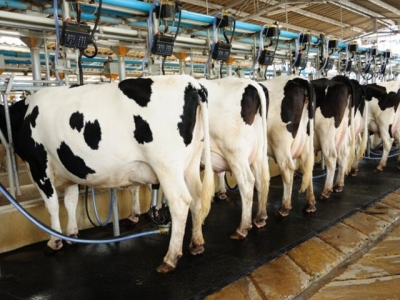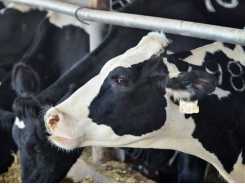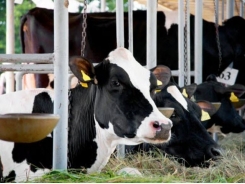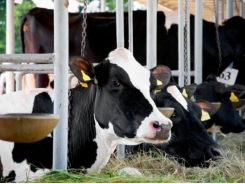Feeding cows milk that may contain antibiotic residues - whats the risk?

EFSA says the feeding to calves of colostrum and milk containing residues of antimicrobials that could select for antimicrobial-resistant bacteria should be avoided.
Besides antimicrobial-resistant bacteria in calf faeces, the Authority, in a recently published opinion, said farmers should also pay attention to the presence of antimicrobials in calf faeces, which could also contribute to the development of AMR in the farm environment.
The Commission had asked EFSA to (1) assess the risk for the development of antimicrobial resistance (AMR) due to feeding on farm of calves with colostrum potentially containing residues of antibiotics.
The EU executive body also asked the Parma based risk assessor to (2) review the risk for the development of AMR due to feeding on farm of calves with milk of cows treated during lactation with an antibiotic and milked during the withdrawal period. Moreover, it called on EFSA (3) to propose possible options to mitigate the risk for the development of AMR derived from such practices.
In terms of the first mandate, the Authority, said its assessment focused on colostrum and transition or post-colostral milk, from day 1 to 5.
Read the label
EFSA’s panel on Biological Hazards (BIOHAZ) concluded that when the interval from the dry-off treatment until calving is as long as or longer than the minimum specified in the summary of product characteristics of the antimicrobial product, fecal shedding of antimicrobial resistant bacteria will not increase when calves are fed colostrum from treated cows.
When cows calve earlier than the minimum withdrawal period specified in the antimicrobial product summary, the levels of antimicrobial in the colostrum are higher, and therefore, there is an increased probability of shedding of antimicrobial-resistant bacteria by calves receiving the colostrum. “However, the available evidence is insufficient to quantify this increase, and no effect was observed in the single observational study dealing with this subject,” said the EFSA experts.
In terms of the second risk evaluation request, EFSA concluded that milk from cows receiving antimicrobial treatment during lactation contains substantial residues during the treatment and withdrawal period. “Consumption of such milk will lead to increased fecal shedding of antimicrobial-resistant bacteria by calves,” said the Authority.
Calves may be fed with milk originating from the same farm that potentially contains residues of antibiotics, including:
- Colostrum of cows treated with long-acting antibiotics at the start of their dry period
- Milk of cows that have been treated during their lactation with an antibiotic and which have been milked during the withdrawal period.
The potential risk for development of AMR due to such practices is unclear, said the Commission.
Risk mitigation
Looking at the third demand from the Commission, EFSA said there are three principal approaches for reducing the risk for development of AMR derived from feeding waste milk or colostrum containing antimicrobial residues to calves.
Measures for restricting the feeding of milk and/or colostrum from treated cows to calves include:
1) Completely prohibiting the use of milk from treated cows
2) Prohibiting the use of milk from cows treated with antimicrobials of specific importance in human health care, i.e. the highest priority critically important antimicrobials (CIAs)
3) Prohibiting the use of milk when the level of residues is expected to be high, i.e. during treatment or after intramammary administration.
EFSA also noted measures to destroy antimicrobial residues before feeding. “Most of the approaches focus on the reduction of β-lactams - penicillin or cephalosporin - which are the most degradable and frequently used antimicrobials in milking cows. Less evidence is demonstrated in the literature against other antimicrobials used in dairy cows.
“β-Lactams can be degraded to a level below the detection limit by direct incubation with specific β-lactamases. Fermentation with β-lactamase-producing microorganisms can efficiently reduce penicillin and cefquinome as was reported in two studies. The main drawbacks are an increase in microbial load and the lack of knowledge of the mechanism of action.
“[The] combination of ultrafiltration and permeate washes and electrochemical oxidation are not easily applicable on the farm level but have the potential to reduce a broader spectrum of antimicrobials.
“Increasing the pH in the milk to 10 has the potential to efficiently reduce the concentration of certain antimicrobials (at least cefquinome) as was shown in one study.
“The effectiveness for a broader range of antimicrobials and the suitability of this milk to be fed to calves needs further consideration.”
The Authority noted options to mitigate the presence of the resistant bacteria in raw milk or colostrum are mainly based on thermal inactivation. “Heat treatment at suitable temperature/time combinations will kill the vegetative bacteria (including antimicrobial-resistant ones) in raw milk and colostrum. Non-thermal options (e.g. microfiltration, centrifugation) are less effective and are not easily practicable at the farm level.”
It added that temperature/time combinations would kill the vegetative bacteria, including antimicrobial-resistant ones, in raw milk and colostrum. “Non-thermal options (e.g. microfiltration, centrifugation) are less effective and are not easily practicable at the farm level.”
Lessons for industry
Richard Murphy, director of research, Alltech, told us the EFSA opinion presents a number of areas to consider along with lessons for the industry.
Essentially the use of good management practices will be vital in the event that antibiotics have had to be administered, he said. Producers will, for instance, need to avoid feeding colostrum and milk containing antibiotic residues to calves, particularly the so-called critically important antimicrobials (CIAs), said Murphy.
“While our understanding of the role of residue passage through colostrum and milk and the development of antimicrobial resistance in the gut is somewhat limited at present, there is some excellent data available to work from.
“The feeding of contaminated colostrum and milk can potentially lead to problems not only with the development and establishment of anti-microbial resistant strains within the gut but also can lead to reductions in the overall microbial diversity and have knock on impacts on the future health of the calf as it matures.
“We know for instance, that reductions in microbial diversity are associated with an increased risk of pathogen colonisation. This effectively means that the inadvertent administration of antimicrobials can lead to the development of a vicious cycle. In essence, the microbial diversity in the gut is reduced, antimicrobial resistance develops in tandem with this and the risk of future pathogen colonisation is increased.
“Additionally, there are environmental considerations to be made whereby producers need to consider the impact of passage of both antimicrobial residues and antimicrobial resistant strains through the faeces into the farm environment. This again can lead to the long term development and build-up of antimicrobial-resistance,” he continued.
Ultimately, though, it is an area that does need further work, particularly with regard to understanding the build-up and lifespan of antimicrobials in milk and colostrum, along with work to define the threshold for residues beyond which resistance is selected for, added Murphy.
EFSA and EMA opinion on AMR reduction strategies
Meanwhile EFSA along with European Medicine Agency (EMA) experts issued a joint opinion this month saying they have reviewed the measures taken in the EU to reduce antimicrobials use in animals and stress that there is no one-size-fits-all solution.
“Successful strategies follow an integrated, multifaceted approach which takes into account the local livestock production system and involves all relevant stakeholders from governments to farmers.
“Alternatives to antimicrobials that have been shown to improve animal health and thereby reduce the need to use antimicrobials include vaccines, probiotics, prebiotics, bacteriophages and organic acids,” said the joint statement.
However, reducing the use of antimicrobials and finding alternatives is not enough, said the EMA and EFSA. “There is a need to re-think the livestock system by implementing farming practices that prevent the introduction and spread of the disease into farms and by considering alternative farming systems which are viable with reduced use of antimicrobials. Education and awareness of AMR should be addressed to all levels of society but in particular to veterinarians and farmers.”
In February 2017, EFSA and the European Centre for Disease Prevention and Control (ECDC) will publish their annual report on the levels of antimicrobial resistance in food, animals and humans across the EU.
EFSA, EMA and ECDC are also working on a report that assesses the link between consumption of antimicrobials and development of resistance in bacteria found in animals and humans – due to be published at the end of July 2017.
By the end of 2017, the three agencies said they would propose a list of indicators enabling risk managers to monitor the reduction of antimicrobial resistance and the use of antimicrobials in humans, food-producing animals and food.
“There are only a few new antibiotics in the development pipeline, hence those already available need to be used responsibly, both in humans and animals. Collecting data on AMR and antibiotic consumption is key to putting into place effective measures to control AMR and retain the effectiveness of antimicrobials for the benefit of public and animal health,” said Professor Guido Rasi, EMA’s executive director.
Related news
Tools

Phối trộn thức ăn chăn nuôi

Pha dung dịch thủy canh

Định mức cho tôm ăn

Phối trộn phân bón NPK

Xác định tỷ lệ tôm sống

Chuyển đổi đơn vị phân bón

Xác định công suất sục khí

Chuyển đổi đơn vị tôm

Tính diện tích nhà kính

Tính thể tích ao




 Dairy calf diets: what is the impact of…
Dairy calf diets: what is the impact of…  Limited diets with high DDGs inclusion support growth,…
Limited diets with high DDGs inclusion support growth,…